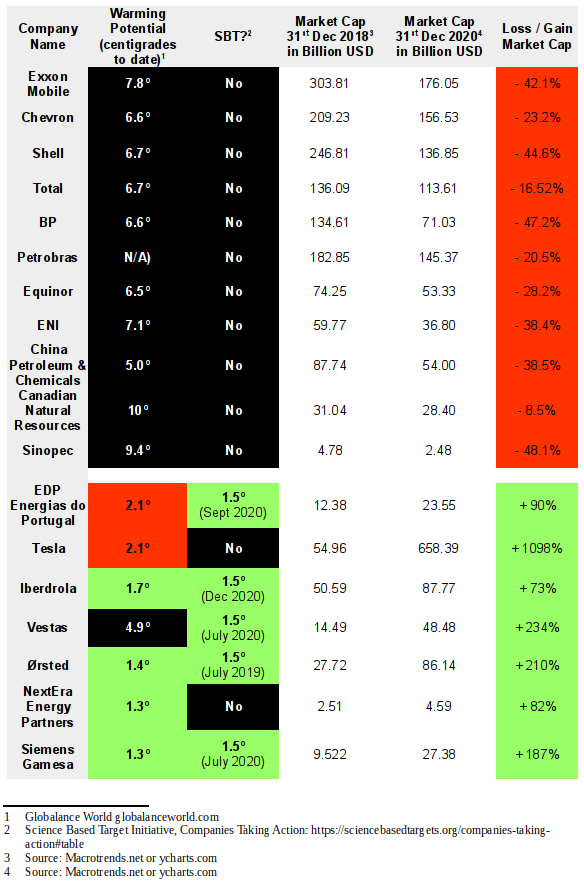
Over the last few months I have looked at key players in Footwear & Fashion, and in the Finance Industry, and how their performance looks like in terms of Climate Trajectory.
In this post I would like to look like at energy companies – both traditional and more ‘contemporary’ – and ask:
- What is their Climate Trajectory?
- Do they engage with the Science Based Target Initiative? and
- How did their market capitalisation develop over the most recent past, specifically the last couple of years, as efforts to decarbonise are speeding up?
The Why
Carbon – together with biodiversity – is one of THE most critical dimensions among the Planetary Boundaries. Because the already existing overshoot is putting our civilisation at risk. So far nothing new under the sun.
However, while biodiversity overshoot is not easy to measure, carbon is a different story entirely. It is so relatively easy to measure that doing so is even enshrined in reporting requirements for listed companies. Example of which are the TCFD (Taskforce for Climate-related Financial Disclosure) recommendations – by now often indeed turned into a requirement – to show investors scenarios with varying carbon/temperature trajectories and the risk for the company.
The big elephant in the room is of course:
- How do companies perform right now in terms of their carbon footprint? And:
- Do they have at the least commitments to work on a Paris Agreement trajectory?
The icing on the cake for energy companies: whether or not the inflow of money – hence the total value of their stocks – gives us an idea of how their future is being assessed by investors at large. And thereby also indirectly by many of us through our pension funds.
The Energy Industry and the Paris Agreement
Most readers will know the Science-based Targets initiative. A 5-step process for companies to commit, then set, and subsequently report against climate goals in alignment with the Paris Climate Agreement. Any company with aspirations to be public about their commitment can do so by signing up, and then moving through this quite rigorous process.
What is much tougher to know is the companies’ status quo , i.e. where they are right now on this journey. And how big the spread between status quo and publicly committed aspiration is. And hence also, how challenging their effort may proof to be in the years to come.
When I looked at fashion companies and their carbon trajectory, I was able to rely on data coming out of the finance industry (specifically: from GlobalanceWorld), intended to scrutinise investable assets. The same held true this time also as I was looking at energy companies.
Ironically though, the same was not the case when I looked at the Finance Industry.
Hence, armed with the list of participants in the Science-Based Targets initiative, and fairly recently published insights from GlobalanceWorld, the following table summarises the insights we can glean by comparing them side-by-side:

Note: these are evidently just a few of the energy companies available. They selection is driven by data availability, size of the respective companies, and then just the curiosity of the author.
Looking over the table, it becomes apparent that – no surprise – there is a vast gap between ‘traditional’ and hence at origin petroleum-based energy companies, and their more modern-times competitors.
What can be inferred from their market capitalisation: on the surface there seems to be a direct correlation between these company’s climate performance and their investability. Albeit – correlation is not causation – there are nuances to be considered: Canada Natural Resources performance is abysmal in terms of Climate Trajectory, but the company’s overall value has by far not suffered as much as one would expect, or is seen in their peers.
Something not dissimilar seems to be going on for the French Total Group.
But even among the renewable companies relevant differences may and do exist.
Ørsted for one probably earned its recent flagging as supposedly ‘most sustainable company in the world’.
At the example of Vestas, and – to a lesser extent – Tesla and Next Era however, it is evident that just proving renewable energy solution does not mean that a company is necessarily ‘in line’ with the Paris Agreement trajectory.
For now though, investors seem to think that indeed these companies are genuinely a better deal, and this is represented in how their market capitalisation has developed, and keeps doing so.
And last, but certainly not least:
It is extremely interesting to see how many of the new and innovative players have taken the plunge to commit to Science Based Targets. This albeit calculations by 3rd parties seem to indicate that they are typically well on the way of being within the necessary margins.
Maybe just as interesting: The two US companies among them – TESLA and NextEra – do not seem to think that SBTs are worth their while …

